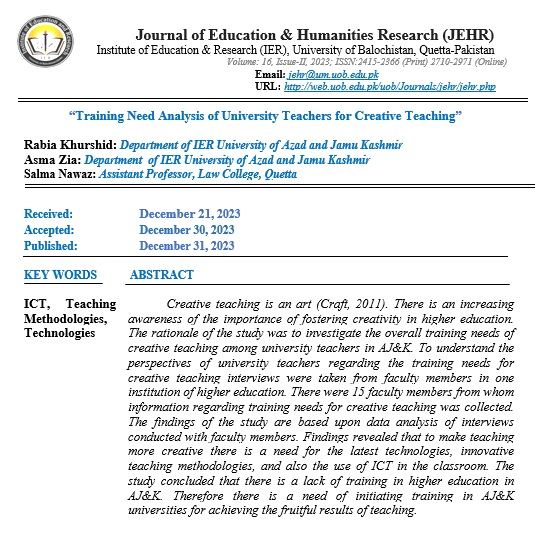Training Need Analysis of University Teachers for Creative Teaching
Abstract
Creative teaching is an art (Craft, 2011). There is an increasing awareness of the importance of fostering creativity in higher education. The rationale of the study was to investigate the overall training needs of creative teaching among university teachers in AJ&K. To understand the perspectives of university teachers regarding the training needs for creative teaching interviews were taken from faculty members in one institution of higher education. There were 15 faculty members from whom information regarding training needs for creative teaching was collected. The findings of the study are based upon data analysis of interviews conducted with faculty members. Findings revealed that to make teaching more creative there is a need for the latest technologies, innovative teaching methodologies, and also the use of ICT in the classroom. The study concluded that there is a lack of training in higher education in AJ&K. Therefore there is a need of initiating training in AJ&K universities for achieving the fruitful results of teaching.
References
Antley, T. (2020). What Is Professional Development and Why Is It Important. Retrieved from https://www.webce.com/news/2020/07/16/professional-development.
Beghetto, R. A., & Kaufman, J. C. (2017). Nurturing creativity in the classroom. New York, NY: Cambridge University Press
Benlamri, F. (2013). Creative Teaching. Democratic and Popular Republic of Algeria, 9-11.
Berg, B. (2001). Qualitative research methods for social sciences. Retrieved from Boston: Pearson education: https://mythoyibi.files.wordpress.com
Bleedorn, B. (2005). An educational track for creativity& other quality thinking process. Lanham, Maryland: The Scarecrow Press, Inc.
Bohm, D. (1998). On creativity. London, UK: Routledge.
Brinkman, D. (2010). Teaching creatively and teaching for creativity. Arts Education policy review, 111 (2) 48-50.
Charlile, O., & Jordan, A. (2012). Approaches to creativity: A guide for teachers. Maidenhead: Open University Press.
Craft, A. (2003). The limitation to creativity in education: Dilemmas for the educators. British Journal of Educational Studies, 51, 113-127.
Craft, A. (2008). Creativity and early years settings. In A. Paige-Smith, & A. Craft (Eds.), Developing reflective practice in the early years (pp. 83-114). Cresskill, NJ: Hampton.
Craft, A. (2011). Approaches to creativity in education: United Kingdom. In J. Sefton-Green, P.
Duffy, B. (2006). Supporting creativity and imagination in the early years. Buckingham England: Open University Press.
Fautley, J. S. (2007). Creativity in Secondary Education. SouthernHay East: Learning Matters Ltd.
Gall, M., & Breeze, N. (2008). Music and jay: An opportunity for creative collaborations in the classroom. International Journal of Educational Research, 47(1), 27-40
Hattie, J. (2009). Visible learning: A synthesis of over 800 Meta-Analyses Relating to Achievement. London: New York Routledge
Jeffre, B. & Craft, A. (2006). Creative learning and possibility thinking. In B. Jeffrey (Ed.), Creative learning practices. London, UK: Tufnell Press.
Johnson, A. (2015). Teaching is a science, an art, and a craft. United State.
King, k. (2014). Skills and education for all. International Journal of Training Research, 16- 34.
Lubart, T. L., Mouchiroud, C., Tordjman, S., & Zenasni, F. (2015).Psychology of Creativity. Paris: Armand Collin.
McCarthy, J. & Anderson. (2000). Active Learning Techniques Versus Traditional Teaching Styles. Innovative Higher Education, 24,279-294.
Mishra, P. & Mehta, R. (2017). What we educators get wrong about 21st-century learning: Results of a survey. Journal of Digital Learning in Teacher Education, 33(1), 6–19.
Murad, F. N. (2017). Innovative Teaching Has a Positive Impact on the Performance of Diverse Students. Sage, 25-27.
Murtaza, M. H. (2011). Staff Development Needs in Pakistan Higher Education. Journal of College Teaching and Learning, 5-6.
Rethinking, R. f. (n.d). Exemplary classroom resources reviewed by teachers for teachers. Retrieved 2021, from https://resources4rethinking.ca/en/about.
Rinkevich, J. L. (2011). Creative teaching: Why it matters and where to begin. The Clearing House: A Journal of Educational Strategies, Issues, and Ideas, 219-223.
Runco, M. (2006). Creativity Theories and Themes. New York: NY: Elsevier.
Sawyer, R. (2004). Creative teaching: Collaborative discussion as disciplined improvisation. Educational Researcher, 33 (2), 12-20
Stein, M. I. (2012). Stimulating Creativity. New York: Academic Press, Ltd.
Sternberg, R. J. (2006). The Nature of Creativity. Creativity Research Journal, 87-98.
Sternberg, R. J. (2015). Teaching for creativity: The sounds of silence. Psychology of Aesthetics, Creativity and the arts, 115-117.
Strom R., &. S. (2002). Changing the rules: Education for Creative Thinking. Journal of Creative Behavior, 36, 183-2000.
Suri, H. (2011).Purposive sampling in qualitative research synthesis. Qualitative Research Journal, 11(2), 63-75.
Tang, J. B. (2011). Teaching for Quality Learning. England: Open University Press.
The team, C. (2020). The importance of fostering creativity in the classroom. Retrieved from https://medium.com/canva/the-importance-of-fostering-creativity-in-the-classroom-34c94b99281d.
Tharp, R. G, (2000). Teaching transformed: Achieving, excellence, fairness, inclusion, and harmony. Boulder, CO: West view Press.
Villegas-Reimers, E. (2003). Teacher professional development: Paris: International Institute for Educational Planning. . Creativity Research Journal, the literature. UNESCO: International Institute for Educational Planning.
Wisdom, J. (2007). Developing higher education teachers to teach creatively. Developing creativity in higher education: London Routledge, 183-196.
Woods, P. (1995). Creative Teachers in Primary schools. UK: Open University Press.
Zhao, Y. (2012). World-class learners: Educating creative and entrepreneurial Zhou, C. (2016). Research on Creative Problem-Solving Skill Development in Higher Education. Denmark: IGI Global Publisher of Timely Knowledge.




